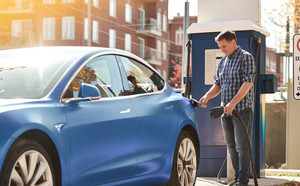How does your car's electrical system work?
By Kijiji Autos
Cars have been so integral to our lives that we tend to take for granted how they work. We know a car needs gas, but we barely spend any time learning about the very thing that keeps the car running: the car's electrical system.
Your well-being remains our top priority. Please seriously consider whether in-person meetings are necessary and visit our for more information.
Knowing more about how your car’s electrical components work can save you unnecessary trips to the mechanic or—worse—expensive tows.
All fuel-powered engines have the same basic components that make up a vehicle’s electrical system. It doesn’t matter if you’re riding a 1967 Shelby Mustang Fastback or a heavy-duty work vehicle, you’ll find all of these parts under your hood:
Car battery
The car battery is responsible for every electrical component in your car, from the blinkers to the dashboard to the radio. The battery helps start the car, but it’s also responsible for providing the car with an even energy supply. You probably know from experience (or just from how batteries work) that if the battery dies, your car won’t start. A battery can last up to five years, but harsh Canadian winters and bad driving habits (like forgetting to turn the lights off) can reduce its lifespan.
Here are common signs that your battery might be on the fritz:
- It takes a few seconds longer to start.
- Your Check Engine light comes on.
- Your car battery starts to smell like rotten eggs.
- Your battery case looks bigger than it used to.
- Your battery is over three years old.
Alternator
The alternator gets its name from its primary function, which is to generate alternating current (you know, the AC in AC/DC). It converts mechanical energy into electricity, which powers everything in the car and recharges the battery. Here are common warning signs that your alternator is failing:
· The warning light comes on (don’t ignore this).
· You have trouble starting the car.
· The headlights appear weak or start to flicker.
· Rattling or clunking noises.
Starter motor
The starter motor works alongside your battery to start the car. In the few seconds needed to insert the key into the ignition and turn it, an entire series of fantastic mechanical feats take place in careful and quick succession. During this rapid process, the starter motor is employed to turn the engine over to allow it to suck in enough air and fuel to cause combustion.
If you hear a loud click or a grinding sound when you try to start the car, your starter motor may be loose or needs to be replaced.
Wires, connectors and fuses
All the electrical components of your car are connected by a series of cables. They’re located throughout the car all the way to the trunk and are covered with insulation. Wires vary in diameter and are colour coded according to their voltage. Connectors make cars easy to service because they allow a mechanic to reach in and remove the faulty wires.
Fuses are in charge of keeping wires at a stable temperature. Your car likely has two fuse panels: one in the glove compartment and the other in the engine compartment. You can use a continuity tester to find out if the fuse is blown or simply pull it out and take a look.
Learn more about your car with Kijiji Autos
Empower yourself with more car knowledge by browsing through our helpful tips and how-tos, like this beginner guide for first-time car owners. Find your next dream car on Kijiji Autos.
Easily find your next ride on Kijiji Autos
Search nowHow Long Can a Car Sit Unused?
How long can a car be left without starting it? Keep reading to explore everything you need to know about unused cars.Costs of Installing an Electric Car (EV) Charging Station in Canada
Installing a home EV charger can come with additional fees beyond purchase and installation. Here's a list of factors that can affect the price of a home EV charger.Toronto to Calgary Road Trip: Routes & Tips
Planning on driving from Toronto to Calgary? Here are some routes and tips to help you along the way.Flat Tire vs Blowout: What's the Difference & What Should You Do?
The main difference between a flat tire and a blowout is that a blowout often feels like an explosion has occurred underneath your vehicle. Blowouts can cause sudden and drastic changes to the handling of your vehicle and can lead to minor or even serious accidents.7 items you can fit in an SUV: TVs, mattresses and more
Discover seven common items that fit in an SUV below.Tips to help protect your vehicle and budget for car repairs
When shopping for your next vehicle, it's always a good idea to keep hidden costs in mind. Before you buy, let's look at how much it can cost to maintain a car in Canada, how much you could budget for annual maintenance and repairs, and how to help protect your car against damage and depreciationThe top three best paint protection options for your vehicle
Buying a new vehicle is a great experience. Nothing beats hitting the road in a car you bought fresh off the lot. However, as fun as it is to finally get behind the wheel of your new ride, it's important to take your time through the process.What is the value of undercoat protection on your vehicle?
When you buy a new vehicle, protecting it so that it lasts as long as possible is definitely top of mind, whether that's through security upgrades or an extra coat of paint. But how often do you consider the care and safety of your vehicle’s undercarriage?Financial guide: post-pandemic car shopping and gas price hacks
With populations locked down and international borders closed the global supply chain has been disrupted on a massive scale, pushing up inflation around the world and raising the cost of everything that people need to get back to normal. Here are a few tips you can use to grab the vehicle you want without breaking the bank.10 tips to help make the road a better and happier place
We have all, at some point, been responsible for making the roadways stressful in one way or another. Alternatively, we are all equally capable of making the road a happier place. Let’s explore 10 unique ways we can help make the driving experience better again, for everyone's sake.








